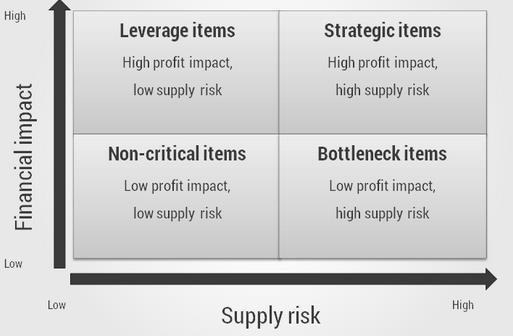In 1983, Peter Kraljic created a matrix called Kraljic portfolio purchasing model that could be used to analyse the purchasing portfolio of a company.
This matrix helps a company gain an insight into the working methods of the purchasing department and how they spend their time on various products.
The Kraljic portfolio purchasing model also makes clear which articles can be subcontracted and therefore do not have to be ordered again and which articles involve a particular risk.
Dimensions
The Kraljic portfolio purchasing model is based on two dimensions by which the purchased materials and/or products can be classified.
- Profit impact – This is defined from low to high. What is the strategic importance of the purchase of certain materials? What added value do they deliver in the production line and what effect do the costs of these materials have on the company’s profitability?
- Supply risk – This is also defined from high to low. To what extent is supply complex; is there abundance or scarcity? To what extent are the materials up-to-date and have the latest technology and materials substitutions been used? What are the logistics costs and are there monopoly or oligopoly conditions?
Product categories
Peter Kraljic distinguishes four types of product categories in these two dimensions:
- Strategic items (High profit impact and high supply risk) – These types of products are purchased from one supplier. There may be a balance of power between the company and the supplier, but when this supplier ceases to deliver, purchasing stagnates. In general, raw materials belong to this category. Raw materials determine to a large extent the value of the cost price of the finished product.
- Bottleneck items (Low profit impact and high supply risk) – These items do not represent a high value but they are a vulnerable factor in the entire supply chain. These are products that are essential for the production process but they are difficult to obtain. There is an imbalance of power between the company and the supplier, in which the supplier is the dominant factor. By creating buffer stock of these scarce items and by finding alternative suppliers, a company can undermine this position.
- Leverage items (High profit impact and low supply risk) – These types of products can easily be purchased from different suppliers and they determine to a large extent the value of the cost price of the finished product. A minor change in price or a change in quality will strongly affect the cost price. In the balance of power between the company and the supplier, the company is the dominant factor. By concluding good framework agreements and drawing up targeted pricing, the relationship between the company and the supplier continues to be in harmony.
- Non-critical items (Low profit impact and low supply risk) – These types of products cause the least problems with respect to purchasing performance. Such products represent a low value and they can be purchased in different varieties and from different suppliers. Most raw materials and substances fall into this category. There is a balance of power between the company and the supplier. By increasing product standardisation, much time and money can be saved.

Steps in the purchasing process
Peter Kraljic recommends the following steps in the entire purchasing process:
- Prepare portfolio analysis
- Determine criteria for profit impact and supply risk
- Determine the detail level of the portfolio analysis
- Fill in the matrix
- Analyze and discuss results
- Determine purchasing portfolio strategy and improvement actions per quadrant of the framework.
- Implement and monitor strategy
This step-by-step makes it easier to control stock management. This prevents obsolescent stock and excess supplies and this leads to cost reduction.
Spreading
Using the Kraljic portfolio purchasing model, an organization can professionalize and improve its purchasing performance which may produce considerable cost savings.
In order to avoid unnecessary risks, it is important to spread the goods across the four quadrants. A supplier should not have the upper hand nor have power over an organization. Precondition is that each product or product group can be placed into the matrix.
Preferably, a product is placed only in one of the quadrants. When agreement has been reached about the position of the products within the Kraljic portfolio purchasing model, it can be determined which actions need to be taken to achieve a better positioning.
The purchasing strategy can be prepared for each part of the Kraljic portfolio purchasing model. Subsequently, it can be concluded whether a product is in the right quadrant or whether it would be better to move it to another quadrant. In that case, discussions must be had with the supplier and new supply terms and conditions should be drawn up.

